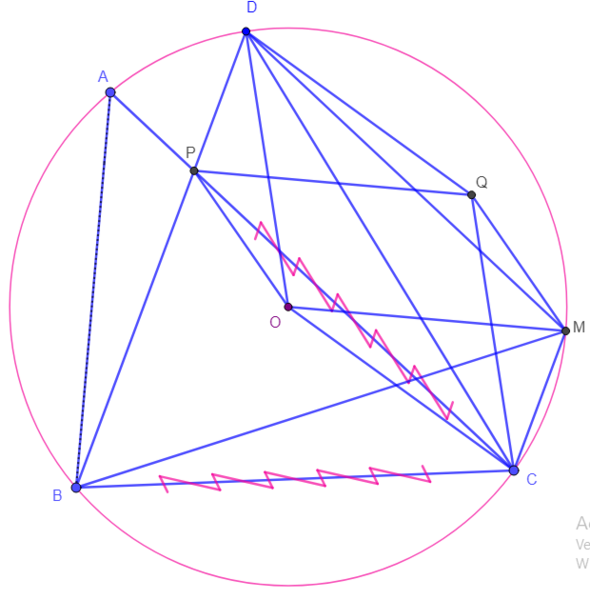Y by Rounak_iitr, OronSH, peace09, ItsBesi
Let  be a triangle with
be a triangle with  let
let  be the circumcircle of
be the circumcircle of  and let
and let  be its radius. Point
be its radius. Point  is chosen on
is chosen on  such taht
such taht  and point
and point  is the foot of the perpendicular from
is the foot of the perpendicular from  to
to  . Ray
. Ray  mets
mets  again at
again at  . Point
. Point  is chosen on line
is chosen on line  such that
such that  and
and  lie on a line in that order. Finally, let
lie on a line in that order. Finally, let  be a point satisfying
be a point satisfying  and
and  . Prove that
. Prove that  lies on
lies on  .
.






![[asy]
size(6cm);
defaultpen(fontsize(10pt));
import olympiad;
import geometry;
pair A = (1,4);
pair B = (0,0);
pair C = (4,0);
pair P = reflect(C,incenter(A,B,C)) * B;
pair D = 2 * foot(circumcenter(A,B,C), B, P) - B;
pair Q = circumcenter(C,D,P);
pair S = foot(P,A,B);
draw(A--B--C--cycle, linewidth(1));
draw(Q--C, blue+1, StickIntervalMarker(1, 1, p=blue+1, size=0.3cm));
draw(Q--P, blue+1, StickIntervalMarker(1, 1, p=blue+1, size=0.3cm));
draw(Q--D, blue+1, StickIntervalMarker(1, 1, p=blue+1, size=0.3cm));
draw(P--S, blue+0.7);
draw(C--B, black, StickIntervalMarker(1, 2, p=black, size=0.3cm));
draw(C--P, black, StickIntervalMarker(1, 2, p=black, size=0.3cm));
draw(B--D, black+0.7);
draw(circle(A,B,C), black);
dot("$A$", A, dir(112));
dot("$B$", B, dir(-142));
dot("$C$", C, dir(-39));
dot("$P$", P, 1.5*dir(25));
dot("$D$", D, dir(87));
dot("$Q$", Q, dir(-143));
dot("$S$", S, dir(166));
[/asy]](http://latex.artofproblemsolving.com/7/b/0/7b0dbe1f5b3d6226a5622f3883ae765ac0b823a6.png)
 so
so 
 is real, so the solution is complete.
is real, so the solution is complete. and the first part of the claim follows by Side-Angle-Side congruence. Then, note that
and the first part of the claim follows by Side-Angle-Side congruence. Then, note that  so
so  and the second part of the claim follows by Side-Angle-Side congruence.
and the second part of the claim follows by Side-Angle-Side congruence.  but
but 


![[asy]
/* Converted from GeoGebra by User:Azjps using Evan's magic cleaner
https://github.com/vEnhance/dotfiles/blob/main/py-scripts/export-ggb-clean-asy.py
*/
real xmin = 2.5, xmax = 20.5, ymin = -9., ymax = 6.;
pen pri; pri=RGB(24, 105, 174);
pen sec; sec=RGB(217, 165, 179);
pen tri; tri=RGB(126, 123, 235);
pen fil=invisible;
pen sfil=invisible;
pen tfil=invisible;
pair O = (9.,-2.);
pair A = (5.8,3.56);
pair B = (4.,-6.);
pair C = (14.00935,-6.00748);
pair P = (7.49139,1.58879);
pair S = (5.49946,1.96383);
pair D = (8.79012,4.41167);
pair Q = (13.79180,0.40034);
pair T = (13.67545,3.82738);
pair R = (10.95662,2.67414);
pair E = (11.83131,3.76477);
import graph;
size(10cm);
pen fueaev = rgb(0.95686,0.91764,0.89803);
pen zzttqq = rgb(0.6,0.2,0.);
pen fsfsff = rgb(0.94901,0.94901,1.);
draw(A--B--C--cycle);
filldraw(circle(Q, 6.41152),white+0.1*pri, pri);
draw(circle(O, 6.41510), linewidth(0.6));
draw(A--B, linewidth(0.6) + zzttqq);
draw(B--C, linewidth(0.6) + zzttqq);
draw(C--A, linewidth(0.6) + zzttqq);
draw((xmin, -0.18828*xmin + 2.99930)--(xmax, -0.18828*xmax + 2.99930), linewidth(0.6) + linetype("2 2"));
draw(B--D, linewidth(0.6));
draw(C--T, linewidth(0.6) + dotted);
draw(T--A, linewidth(0.6) + dotted);
draw(B--E, linewidth(0.6) + dotted);
dot("$O$", O, dir((8.000, 20.000)));
dot("$A$", A, dir((8.000, 20.000)));
dot("$B$", B, dir(210));
dot("$C$", C, dir(320));
dot("$P$", P, dir(30));
dot("$S$", S, dir(40));
dot("$D$", D, dir(100));
dot("$Q$", Q, dir((8.820, 15.966)));
dot("$T$", T, dir((8.455, 15.262)));
dot("$R$", R, dir(0));
dot("$E$", E, dir((8.869, 15.523)));
[/asy]](http://latex.artofproblemsolving.com/d/c/9/dc9eb592cf521cfddf96cee60f8b29111f3bd2b4.png)
![[asy]
/* Converted from GeoGebra by User:Azjps using Evan's magic cleaner https://github.com/vEnhance/dotfiles/blob/main/py-scripts/export-ggb-clean-asy.py */ /* A few re-additions are done using bubu-asy.py. This adds the dps, xmin, linewidth, fontsize and directions. https://github.com/Bubu-Droid/dotfiles/blob/master/bubu-scripts/bubu-asy.py */ pair A = (24.81281,-5.45037); pair B = (-6.39088,-5.19529); pair C = (0.26530,21.43292); pair P = (18.77311,1.16403); pair Q = (18.92617,19.88811); pair O = (9.29559,5.02962); pair D = (27.95646,3.48480); pair F = (26.85608,19.23164); pair S = (18.71945,-5.40056); pair E = (26.32491,12.81529); pair X = (25.56886,3.68246); pair Y = (23.63508,11.33449);
import graph; size(10cm); pen dps = linewidth(0.5) + fontsize(13); defaultpen(dps); real xmin = -5, xmax = 5, ymin = -5, ymax = 5;
pen ffxfqq = rgb(1.,0.49803,0.); draw((24.64484,9.50029)--(26.47904,10.51004)--(25.46928,12.34425)--Y--cycle, linewidth(0.6) + blue); draw((27.65551,3.50972)--(27.82825,5.59636)--(25.74160,5.76910)--X--cycle, linewidth(0.6) + blue); draw((15.86788,11.32006)--(17.00668,13.07706)--(15.24968,14.21586)--(14.11088,12.45886)--cycle, linewidth(0.6) + blue); draw(A--B, linewidth(0.6)); draw(B--C, linewidth(0.6)); draw(C--A, linewidth(0.6)); draw(circle(O, 18.72470), linewidth(0.6)); draw(C--O, linewidth(0.6)); draw(O--D, linewidth(0.6) + ffxfqq); draw((20.10150,4.13506)--(19.29048,3.31085), linewidth(0.6) + ffxfqq); draw((20.10150,4.13506)--(19.43705,5.08142), linewidth(0.6) + ffxfqq); draw((18.62602,4.25721)--(17.81500,3.43300), linewidth(0.6) + ffxfqq); draw((18.62602,4.25721)--(17.96157,5.20357), linewidth(0.6) + ffxfqq); draw(D--Q, linewidth(0.6)); draw(A--F, linewidth(0.6)); draw(Q--S, linewidth(0.6)); draw(Q--F, linewidth(0.6) + ffxfqq); draw(B--E, linewidth(0.6)); draw(circle((27.14069,8.15005), 4.73602), linewidth(0.6) + linetype("4 4") + red); draw(C--Q, linewidth(0.6) + ffxfqq); draw((11.07121,20.53837)--(10.26018,19.71415), linewidth(0.6) + ffxfqq); draw((11.07121,20.53837)--(10.40676,21.48473), linewidth(0.6) + ffxfqq); draw((9.59573,20.66051)--(8.78471,19.83630), linewidth(0.6) + ffxfqq); draw((9.59573,20.66051)--(8.93128,21.60687), linewidth(0.6) + ffxfqq); draw(C--D, linewidth(0.6)); draw(O--Q, linewidth(0.6)); dot("$A$", A, SE); dot("$B$", B, SW); dot("$C$", C, NW); dot("$P$", P, W); dot("$Q$", Q, NW); dot("$O$", O, W); dot("$D$", D, SE); dot("$F$", F, NE); dot("$S$", S, dir(270)); dot("$E$", E, NE); dot("$X$", X, SW); dot("$Y$", Y, NW); [/asy]](http://latex.artofproblemsolving.com/8/f/a/8fa34a2b9ad93f77151aafe5b9b834881d08eb92.png)


 .
.


 ,
,



